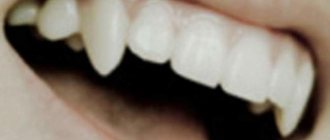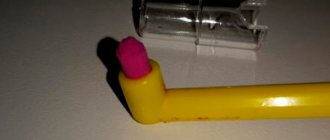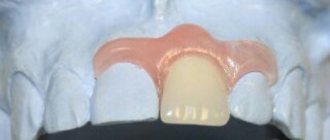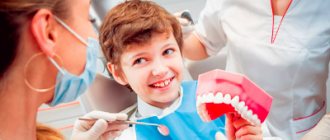When a child grows fangs, in most cases, this process is painful and the temperature rises. Teeth erupt in pairs, on opposite sides of the upper and lower jaw. At about a year old, a child should have approximately 8 teeth. The appearance of fangs occurs at 16-20 months. The fangs appear on the lower jaw first, and later on the upper jaw.
When and how many teeth should appear? Teething in children generally occurs half a year after birth, depending on the developmental characteristics of the body. For some babies, teething occurs earlier, for others later.
If a one-year-old child does not have a single tooth, then this is a reason to consult a doctor . This manifestation indicates a slowdown in metabolism and the presence of serious diseases in the body, such as rickets. You need to worry if a child’s teeth come out too early, in the second or third month of life.
Timing of eruption: when and how much?
The appearance of teeth in a child is characterized by both biological and passport age. The timing of teething is determined by hereditary factors, living conditions, climate, quality of food and water consumed.
For each child, the period of teething is individual . And if you have twins, it does not mean that their teeth will appear at the same time.
Before teeth erupt, they go through 2 stages:
- bookmark;
- formation of a tooth germ.
The first teeth to erupt are the lower row - the two central incisors. Incisors can appear either simultaneously or sequentially. Then, if we assume that teeth are formed in pairs on the upper and lower jaws, the central incisors erupt in the upper row. Later, a series of second paired incisors will grow: two lower lateral and two upper lateral.
How many teeth should a one year old baby have? Typically, one-year-old children already have 8 incisors (4 upper, 4 lower).
After the incisors, the fangs begin to emerge, but they give their place to the first molars, and therefore “tooth gaps” can be traced in their place. Then canines and other molars appear. A child’s fangs emerge at the age of 16-23 months – lower ones, 16-22 months – upper ones.
From the age of seven, baby teeth gradually fall out, and permanent teeth grow in their place. The process of growth of new teeth is carried out in the same way as milk teeth, first the front incisors are replaced, then the lateral ones.
A child's permanent fangs begin to appear after the baby teeth fall out, at about 9 years of age. At 11-12 years of age, the insertion of dental arches ends, and at 17-25 years of age, the formation of teeth ends - the last wisdom teeth appear.
A child has fangs: how to relieve pain and fever
When a child grows fangs, in most cases, this process is painful and the temperature rises. Teeth erupt in pairs, on opposite sides of the upper and lower jaw. At about a year old, a child should have approximately 8 teeth. The appearance of fangs occurs at 16-20 months. The fangs appear on the lower jaw first, and later on the upper jaw.
When and how many teeth should appear? Teething in children generally occurs half a year after birth, depending on the developmental characteristics of the body. For some babies, teething occurs earlier, for others later.
If a one-year-old child does not have a single tooth, then this is a reason to consult a doctor . This manifestation indicates a slowdown in metabolism and the presence of serious diseases in the body, such as rickets. You need to worry if a child’s teeth come out too early, in the second or third month of life.
Symptoms
Symptoms of teething mainly depend on the well-being and health of the child at that time. The appearance of fangs is a rather complex process that causes a lot of inconvenience for children. The process affects the functioning of the entire organism.
The main symptoms of teething in babies:
- irritability, moodiness manifests itself due to a feeling of pain and burning during teething;
- violation of the diet, the child refuses food: there is no need to force him to eat, it is better to give him plenty of drink;
- sleep disturbance;
- swollen gums;
- grasping reflex - the baby pulls objects into his mouth, thus trying to scratch his gums;
- increased salivation;
- in rare cases, a rash on the face is observed;
- formation of diarrhea;
- increase in body temperature to 38-39 degrees.
The main problems with which parents turn to the doctor during teething are increased temperature, loose stool, and gag reflex.
The appearance of teeth cannot cause an increase in temperature of more than 38 degrees. The temperature cannot be maintained for three days. If the temperature is higher than the specified value, you should consult a doctor. Often fever and loose stools are a sign of intestinal disease.
By the way, strong salivation during teething leads to symptoms: cough, hoarseness, runny nose.
What if the bite is not corrected?
Anomalies of occlusion cause physical and psychological discomfort to their owners. Psychological problems are more significant for children and adolescents, as crooked teeth often become a reason for ridicule. Physical discomfort begins already in adulthood, when the body's resources are depleted. Improper distribution of the load when chewing leads to problems in the temporomandibular joints, rapid abrasion of enamel, and periodontal diseases. Accelerated tooth decay requires expensive prosthetics at a much earlier age than would be the case in the absence of occlusal anomalies.
How to help with teething?
The appearance of fangs is a difficult period for a child; he or she is constantly bothered by itching, burning and pain. Eliminating unpleasant symptoms is not an easy task. However, there are many tips that can help your child overcome teething more easily.
Special teethers
First, you need to provide your baby with a variety of teethers, which are filled with liquid or gel inside. Teethers are designed to cool the gums and prevent itching. Such devices must be placed in the refrigerator from time to time to restore their effect. You can also use pacifiers and bottles, which also satisfy the baby's chewing needs.
It is necessary to select pacifiers of a special orthodontic shape and high quality. Incorrectly chosen pacifiers can cause the development of malocclusion. Maintain cleanliness and proper storage of these devices.
Additionally, you can massage the child’s gums with gauze swabs moistened with cold water. This relieves pain and eliminates bacteria from the mouth.
Medications
Medicines are the most effective helpers. There are many ointments, gels and other products. The most commonly used medications that have been tested over the years are:
- Dentinox is a gel containing chamomile and lidocaine that acts as an anesthesia. Use three times a day, there may be side effects such as allergies.
- Baby Doctor first teeth - has an anti-inflammatory effect. Suitable for infants.
- Homeopathy - Dantinorm baby - provides a complex effect, relieves pain, fights digestive disorders, removes inflammation.
The use of any drug should be done after consulting a doctor.
Every mother faces the period when her baby is teething. The process is unpleasant and painful, but you need to go through it with dignity and patience together with your children, helping them in every possible way to cope with pain and fever.
If the appearance of teeth in a baby is delayed, this is due to inhibition of growth and development. Such manifestations are observed in pathologies:
- rickets is a disease of infants that occurs due to the lack of nutrients and vitamins in the child’s body, in particular vitamin D, which slows down the absorption of calcium, which is necessary for tooth growth;
- edentia is a pathology in which the rudiments of teeth are absent; this diagnosis is confirmed using x-rays.
It is important to remember that fever is not always a symptom of teething in a child; it can often be a sign of other more dangerous diseases. Therefore, contact the clinic as soon as possible.
The first teeth appear at the age of 5-6 months. This is a period of important physiological changes in the baby’s body, and is often accompanied by pain, insomnia, and diarrhea. First, the lower and upper incisors erupt, then the premolars, and last are the canines. However, everything is individual, and the order of eruption may be disrupted. Fangs can appear even before the molars come out. When they are ready to appear, white dots appear on the gums, and after a while these areas swell. The pain is due to the fact that the fangs have rather long roots, and they are located very close to the facial nerves.
Many parents wonder, “Can fangs come first?” They can, and you can determine that it is they who are climbing based on several signs.
Symptoms of canine eruption
As a rule, fangs erupt at 16-22 months, but deviations from this interval are also considered normal. The appearance of these teeth is accompanied by the following symptoms:
- Poor appetite. The baby may refuse to eat and even his favorite foods. This symptom should be taken as carefully as possible, as it may indicate the development of other diseases. In this case, it is better to contact your pediatrician.
- Profuse salivation. It occurs not only during the eruption of fangs, but also all other teeth. Of course, saliva causes discomfort to the child. It can accumulate in the folds of the neck and cause skin irritation. It is recommended to wear a bib and remove saliva with a soft cloth, and lubricate the skin with natural baby cream.
- Increased body temperature. When fangs come in, special bioactive substances are produced in the gums, and the temperature can rise to 38 degrees. It often stays at this level for a couple of days. You can bring it down with the help of antipyretics recommended by your pediatrician.
- Disturbances in the gastrointestinal tract. One of the symptoms indicating the eruption of fangs is diarrhea or, conversely, constipation. In some cases, vomiting is observed, which is caused by salivation. In this case, it is also necessary to carefully monitor the child: if the diarrhea does not go away after 3 days, then you should definitely contact a pediatrician to rule out the presence of an intestinal infection.
- Behavioral disorders. Since the baby experiences pain and constant itching in the gum area, he becomes restless, moody, and irritable. During this period, parents should show maximum care and give affection. Active communication with the child, reading rhymes, or looking at a book will distract you from focusing on discomfort.
- Runny nose and cough. These symptoms are observed almost always when fangs come out, but they disappear after a few days.
The period of appearance of baby teeth in children is often characterized by poor health and malaise of the baby. It is difficult to endure the eruption of fangs. This article will tell you how long it takes for a child to grow fangs, as well as what signs accompany this condition.
Factors that influence the process
The process of formation of the dental system is determined by many factors. It depends on:
- individual characteristics of the body;
- heredity;
- the presence of various types of dental anomalies;
- chronic diseases and general somatic pathologies;
- diseases suffered during pregnancy by the mother;
- compliance with hygiene rules;
- biological age;
- disorders of mineral metabolism (mineral dystrophies);
- depth of occurrence of tooth rudiments in the thickness of the bone;
- nutrition;
- social environment;
- transferred and concomitant diseases during the mineralization of teeth, etc.
Heredity and genetic predisposition
Not only the color of hair, eyes, skin and physique are passed on to a person from close relatives. The time of onset of teething is also determined at the genetic level. If the father and mother have milk teeth quite late, then there is every reason to assume that the child will begin this process at the same age. This is perhaps the only factor that cannot be influenced.
READ ALSO: What is the order of teething in children?
Pregnant woman health
Often, the result of a delay in the formation of teeth is the woman’s diseases suffered while carrying a child. For example, toxoplasmosis, which is asymptomatic, as well as diseases of viral or bacterial etiology. A factor influencing late teething may be a congenital heart defect diagnosed in the mother (we recommend reading: causes of late teething).
Women should take into account that the lactation period is very important for the baby, therefore, in the absence of objective reasons, they should not refuse breastfeeding.
Child's health status
Health status also affects the growth and formation of teeth. These include deficiency of vitamins and micro- and macroelements, developmental delays and pathological conditions of the immune system. Eruption may be delayed due to rickets, hypothyroidism, adentia, etc. Some people develop a few teeth and the process stops.
With hypothalamic-pituitary dwarfism and Itsenko-Cushing's disease, the sequence, symmetry and pairing of teeth eruption may change. The etiology of delayed eruption includes disorders of bone formation, especially severe forms.
READ ALSO: when molars are cut in children: symptoms and order of change in primary occlusion
Other factors
- In terms of skeletal maturity, as well as in terms of the criteria for the process of eruption, the female sex is ahead of the male sex.
- A number of experts believe that environmental factors (climatic zone, ecological situation) play a decisive role in the process of teeth appearance.
- With hypofunction of the thyroid gland, teething is delayed, with hyperthyroidism it is accelerated.
- There is an assumption that in children who were born second or third, teething may begin later than usual.
READ ALSO: What medications can help with teething in infants?
Features and timing of appearance
Children's canines are called "triples" because they erupt between the second teeth from the center. The eruption of fangs is considered to be most difficult on the upper jaw. Lower canines usually do not cause any complications when they appear.
Normally, the process should begin between the 16th and 18th months. The lower canines can take longer to grow and only erupt at 20-22 months. According to the observations of pediatricians, when the time approaches for the appearance of fangs, the child already has ten to twelve teeth.
When it comes to the appearance of permanent fangs in children, this usually occurs between the ages of nine and twelve years. In this case, the lower canines appear first, and after a few months the upper ones appear. The period of teething in children, the symptoms of which can be quite different, requires medical supervision, especially when this process is accompanied by a significant deterioration in the baby’s condition.
Signs of teething
The symptoms of teething in a child are specific. They cannot be confused with the growth of other teeth, since they are usually accompanied by severe symptoms. If this period lasts for a couple of months, then this is not considered a deviation, so parents should not panic.
This is justified by the fact that each organism develops differently and the period of physiological changes in children is quite capable of proceeding at its own individual speed. Pediatricians do not set definitive dates for teething, characterizing these dates quite arbitrarily.
The first characteristic signal that a child is getting fangs is the appearance of barely noticeable white dots on the gums. It is noteworthy that such a phenomenon can occur even before the appearance of molars. They usually grow along with the molars, but when they erupt, they are delayed and the molars appear first.
Many parents wonder why fangs, when they erupt, cause so much pain and problems. This is justified by the anatomical features of these teeth: the fangs have very long roots that are located close to the child’s facial nerves. Therefore, the canine in the upper jaw is called an eye tooth (a sign of the eruption of these teeth is usually associated with irritation of the nerve that provides communication with the central nervous system, as well as the upper part of the face).
In most children, the first symptoms of the approaching eruption of fangs occur long before the teeth themselves appear on the horizon. Moreover, signs can develop even 3-4 weeks before teething.
The following are the most common symptoms of the rapid appearance of eye teeth in children:
- Sleep disturbance. At the same time, the child will sleep poorly both during the day and at night. He may have a bad mood, increased tearfulness, moodiness and irritability.
- Excessive salivation, as well as the baby’s desire to chew on any hard objects.
- Deterioration of appetite and often a complete refusal to eat occurs due to severe burning and pain in the inflamed gums, which in turn can acquire a bright red and even bluish tint.
- The appearance of lacrimation, partial redness of the eyes and face.
- Often children in this condition develop obvious signs of acute respiratory viral infection, which will be accompanied by a cough or a profuse runny nose. At the same time, parents should be extremely careful in order to be able to distinguish a true viral infection of the body from false signs of teething.
- The appearance of a gag reflex.
- An increase in body temperature can be observed within 3-5 days, when the inflammatory process is at its peak. Usually after this the final eruption of the tooth occurs and the swelling of the gums subsides.
- Quite rare, but there are cases of a rash appearing on the face.
- In infants, the digestive system can be severely disrupted, which will lead to frequent diarrhea, bloating and gas formation.
Give your baby a teether to relieve the itching and pain.
Important! With frequently recurring diarrhea, children under one year of age rapidly lose moisture from the body, which threatens dehydration and deterioration of kidney function. That is why, if a baby refuses to eat, but at the same time suffers from diarrhea, it is better to provide him with plenty of fluids than to force him to eat food.
Help the baby
The time when the first tooth comes out cannot be called easy. Rather, it is a test for the whole family. Sleepless nights, crying and whims are part of life. There is one consolation: the teeth will come out sooner or later, the torment will end. You need to be patient and learn to identify signs of teeth in a baby in order to help and alleviate the condition in a timely manner. This can be done with medications and mechanical methods.
Medicines
To reduce pain in inflamed gums, it is possible to use gels with a pronounced analgesic and anti-inflammatory effect. Using clean fingers, rub the gel into the gums. The most famous brands are “Kalgel”, “Kamistad”, recommendations should be obtained from a pediatrician.
In case of fever, it is necessary to give an antipyretic drug based on paracetamol or ibuprofen. They also have analgesic properties.
Mechanical methods of assistance
Toys that come in handy are teething toys that are filled with a special gel or liquid. They must be cooled before use.
Bottles or pacifiers with high-quality silicone nipples will come to the rescue.
You can use silicone brushes that fit on your finger. This attachment is used to massage and clean teeth.
Pieces of fruit (apple or pear), dried fruit, crackers, hard cheese, which can be placed in a special device - a nibbler, equipped with a mesh bag for pieces of food. During the process of “salting,” the pieces are turned into puree and are successfully eaten by the baby.
Silicone teething brushes
What not to do
- Press on the gum in order to squeeze it out as quickly as possible;
- Pick (pierce and cut) the place where the tooth appears;
- Use alcohol-containing solutions to treat gums.
These manipulations will lead to gum injury and can cause infection.
After teeth appear, it is necessary to take care of them and show them to the pediatric dentist. He will assess the condition of your gums, examine emerging teeth and give recommendations on how to care for them. You can also start eating adult food, because from the moment the first tooth appears and the child reaches 6 months, complementary foods can be introduced. Recommendations on proper nutrition and tips on how to reduce the risk of caries on “new” teeth can be obtained from your dentist.
Doctor's advice
To make the child feel as comfortable as possible, the following pediatrician recommendations :
- You need to give your child special teething toys, which can be filled with gel or water. With the help of this device, the baby will be able to relieve burning and pain in the gums. At the same time, during this period it is better not to let your child play with toys that have small parts or sharp elements that could cut his gums.
- In order for the child to be able to eat without pain in the gums, doctors advise using special anti-inflammatory and anesthetic gels. The best drugs in this area are Kamistad, Kalgel and Dantinorm baby. Immediately before using such drugs, it is recommended to additionally consult with your supervising physician.
- If the body temperature is high, it will only be possible to bring it down at levels of 38 degrees and above. In this case, it is best to use drugs whose main active ingredient is paracetamol. It is well tolerated, acts quickly and rarely causes unwanted side effects.
- To relieve pain and eliminate bacteria from the gums, they can be massaged with gauze soaked in chamomile decoction.
Food during teething should be neutral and have an optimal temperature, so as not to further irritate the already inflamed and swollen gums.
Nutrition
Proper feeding during this period plays an important role. The diet should contain foods enriched with vitamins A, B and C. It is also necessary to include cottage cheese and milk.
Attempts to feed a child at such a moment do not always end well. Often what is eaten is released in the form of vomiting due to pain. Dehydration sets in as the temperature rises. The main thing is to constantly give the child something to drink, thereby gradually reducing dehydration and lowering the temperature. In cases where you lose control of the situation, you should call an ambulance. The pediatrician will examine you, give recommendations for care, and prescribe products that, if purchased, will make it easier for you to cope.
Which tooth should appear first?
There are no statistics that would indicate that the first tooth should appear in such and such a period. If it existed, the parents would be fully armed and await this day fully prepared. All physical parameters, such as weight, height, closure of the fontanel, are determined by the individuality of the baby, as well as the time for teething.
The formation of teeth occurs in utero without a specific sequence or clear order of their subsequent eruption.
Doctors believe that the order in which teeth appear on the gum surface depends on hereditary factors. If one of the parents’ order was broken, the child can repeat his “feat”.
Can fangs erupt first? Of course, yes, just as the incisors can come in pairs, just as the molars can appear in front of the incisors. Based on the results of observations, it can be noted that the gums swell not only in the place where the tooth should erupt. It happens that the first to emerge from the swollen gum is not the incisor, but the canine, but more often it becomes embedded in the gum and does not appear outward until the upper and lower incisors erupt. To understand whether a tooth has appeared or not, you can lightly tap on the gum with a teaspoon; if you hear a clicking sound, it means the tooth has erupted. Usually, before the day when it appears, the gums become white, and a white stripe is clearly visible in the place of the future tooth.
In 1 case out of 2000, a child gets a tooth in the first month after birth, and every 1000th baby already has a tooth in his mouth from birth. It happens that the first tooth appears at the age of one year or older. Parents do not need to worry about this: if there are no teeth, it means that the stomach is not yet ready for solid food! They will erupt one way or another, and by the age of 3 the baby should have 20 milk teeth, which fall out by the age of 6-7 and are replaced by permanent ones. There is only one pattern: the later teeth appear, the older the child’s age they will change.
Visit to the doctor
In the following situations, you should go to the dentist:
- Teeth appeared late or cannot erupt for a long time;
- Too early eruption;
- There is no tooth, a violation in the sequence and pattern of appearance;
- Incorrect formation of the crown, or the tooth has grown too far from the dentition;
The permanent tooth is not on the dentition
- A black edging is visible on the isthmus;
- The enamel became red, green, dark brown;
- The tooth is damaged.
Parents need to know what the first tooth comes out in a child, and how to accurately recognize this important process, to analyze the correct development of the baby. If you notice any deviations or complications, you need to promptly seek qualified help from a dentist.











